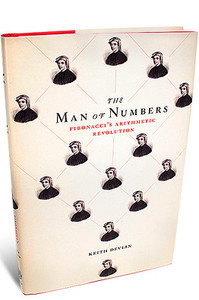Source of book image: online version of the WSJ review quoted and cited below.
(p. A13) Humans have been recording counts for at least 35,000 years, if the notches in a Paleolithic-era baboon’s fibula are an indicator.
. . .
Before the 13th century, European businessmen recorded figures in Roman numerals and computed with their fingers or a counting board. But these creaky accounting systems began to buckle under the growing complexity of regional and international finance. In 1202, Leonardo of Pisa–better known by his family name, Fibonacci–published the “Liber Abbaci,” or “Book of Calculation,” a 600-page tome detailing the rules of Hindu-Arabic arithmetic and algebra. Fibonacci’s volume was directed not to scholars but to merchants, the first work in the West to demonstrate the commercial utility of Eastern mathematics. The book was an instant success and propelled the Pisan maestro d’abbaco to fame.
The “Liber Abbaci” inspired a flood of regionally produced (and lesser) primers on the subject. Arithmetic schools sprang up throughout Italy and would eventually count among their pupils da Vinci and Machiavelli. German merchants flocked to Venice during the 1300s to learn the new accounting practices. In “The Man of Numbers,” mathematician Keith Devlin makes the case that Fibonacci’s book spearheaded the decline and fall of the Roman numeral and transformed scientific, technological and commercial calculation in the West.
At age 15, Fibonacci accompanied his father, a Pisan trade representative, to the North African port of Bugia (now Bejaia, in Algeria). In the preface to “Liber Abbaci,” Fibonacci writes of his early introduction to the “art of the nine Indian figures” and their computational power. After more than a decade of his own studies and tutelage under Arabic mathematicians across North Africa, he returned to Pisa to write his masterwork. Such was the acclaim that Fibonacci appeared before Emperor Frederick II–a colorful intellectual who referred to himself as Stupor mundi or Wonder of the World–and vanquished the emperor’s court mathematician in an arithmetic duel.
. . .
. . . as Mr. Devlin reminds us, even something as prosaic as a sequence of 10 numbers can remake an entire world.
For the full review, see:
ALAN HIRSHFELD. “BOOKSHELF; Counting On Progress; Roman numerals were fine for adding and subtracting. Fibonacci saw that complex math required a better system.” The Wall Street Journal (Thurs., JULY 7, 2011): A13.
(Note: ellipses added; italics in original.)
Book under review:
Devlin, Keith. The Man of Numbers: Fibonacci’s Arithmetic Revolution. New York: Walker & Company, 2011.

